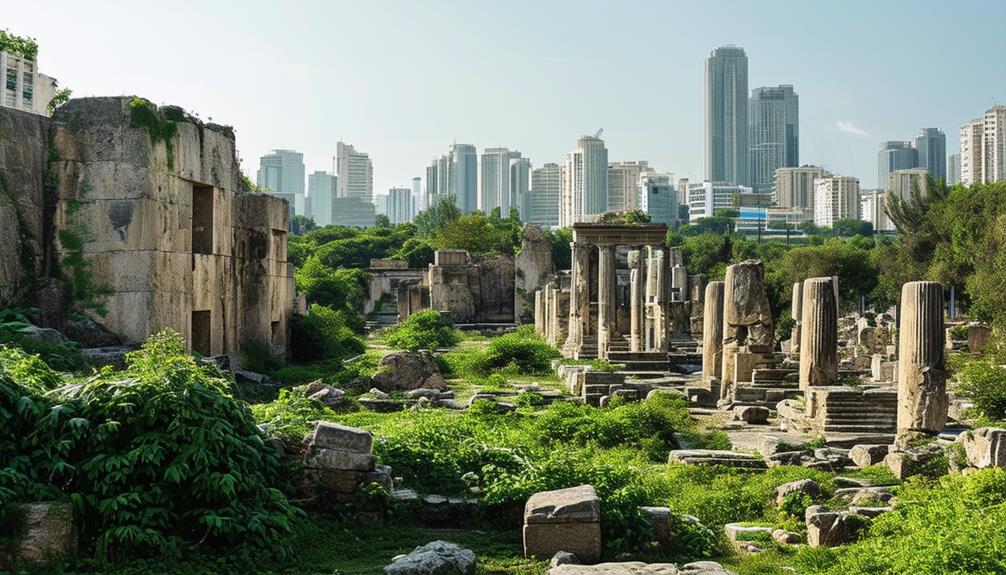The Longest Blackouts in History

Imagine waking up to a world without electricity, where the conveniences of modern life come to a sudden halt. The longest blackouts in history have thrown millions into chaos, whether due to natural disasters, human error, or failing infrastructure. You might think back to the 2003 Northeast blackout or the 2012 India blackout, but there's much more to uncover about these catastrophic events. What causes such prolonged outages, and how do they impact economies and societies? Let's explore the vulnerabilities in our power grids and the lessons learned from these monumental disruptions.
Criteria for Major Blackouts

To define a major blackout, specific criteria must be met to highlight the event's significance. A major power outage is an unplanned event that affects at least 1,000 people and lasts more than one hour. This ensures that the blackout impacts a substantial number of individuals, significantly disrupting daily lives.
A major blackout is further characterized by causing at least 1,000,000 person-hours of disruption. This metric accounts for various combinations of affected individuals and outage duration. For example, if 10,000 people lose power for 100 hours, the criteria are met. Such blackouts have a profound impact on the power grid, often disrupting critical services like hospitals and communication networks.
Causes of major blackouts can include natural disasters, human error, or infrastructure failures, all of which can severely impact power supply and transmission lines. These events are unplanned by the service provider, making them sudden and often difficult to resolve quickly.
The severity and scale of a major blackout are typically assessed based on the number of people affected and the duration of the outage. This assessment helps quantify the total impact on the community and the economy. Understanding these criteria is crucial for grasping the gravity of such events.
Historical Blackouts of the 20th Century
You might recall the 1965 Northeast blackout that plunged over 30 million people into darkness for 13 hours, or the notorious 1977 New York City blackout that resulted in widespread chaos and thousands of arrests. The 1980s and 1990s also experienced significant outages, underscoring the vulnerabilities of our power grids. Let's explore these historical blackouts and their profound societal impacts.
Notable 1960s Outages
The 1960s experienced significant power outages that revealed the vulnerabilities in the electrical infrastructure of the era. One of the most notable events was the 1965 Northeast blackout, which lasted approximately 13 hours and affected over 30 million people across multiple states in the U.S. and parts of Canada. This major blackout was triggered by a failure in the power grid protection system, leading to widespread power failures and significant disruptions, especially in New York City.
In 1969, another major power failure occurred in Florida, impacting over 2 million residents. This outage caused extensive traffic chaos and left major cities like Miami and Fort Lauderdale without power for nearly two hours. These incidents underscored the critical need to enhance the resilience of electrical grids.
The major blackouts of the 1960s highlighted the importance of robust infrastructure to prevent power outages. They served as a wake-up call for utility companies and governments to invest in better technology and protocols. Understanding these historical blackouts helps us appreciate the advancements made in ensuring more reliable power systems today.
1970s Power Failures
Flickering lights and sudden darkness defined some of the most severe power failures of the 20th century. The 1965 Northeast blackout stands out as a remarkable event, affecting over 30 million people across eight U.S. states and parts of Canada for 13 hours. This widespread power outage highlighted the vulnerability of interconnected power grids and the chaos that could ensue from a transmission failure.
Fast forward to 1977, and New York City faced another monumental blackout lasting nearly 25 hours. Unlike the previous event, this blackout resulted in severe consequences, including widespread looting, arson, and the damage of about 1,600 shops. Such incidents underscore the social impact that a power outage can have on densely populated urban areas.
View this post on Instagram
In 1982, the West Coast experienced a significant blackout due to communication failures during high winds, leaving approximately 2 million homes without power. This event further demonstrated how natural factors could trigger transmission failures and disrupt daily life.
These historical blackouts of the 20th century serve as critical lessons on the importance of robust and resilient power grids. Each event emphasized different vulnerabilities, from technical faults to societal responses, shaping how we approach electricity infrastructure today.
1980s-1990s Blackout Events
Power outages during the late 20th century demonstrated the vulnerabilities in modern infrastructure. The 1965 Northeast Blackout, caused by a failure in the power grid protection system, affected over 30 million people across eight U.S. states and parts of Canada and lasted up to 13 hours. This event highlighted the critical need for more robust grid systems.
In 1977, New York City experienced a blackout that lasted nearly 25 hours, resulting in widespread looting and arson. Approximately 1,600 shops were damaged, showcasing how power outages can quickly escalate into social crises.
The 1982 West Coast Blackout was caused by high winds that disrupted power to 2 million homes due to failures in grid communication. This incident emphasized the importance of reliable communication channels within the power grid.
By 1996, blackouts in Western North America affected around 4 million people. The outages were largely due to high summer demand and a failed transmission line, leading to significant economic losses.
Lastly, the 1998 North American Ice Storm left over 3.5 million people without power for extended periods, especially in Quebec. This event underscored the vulnerabilities of power infrastructure during extreme weather conditions.
Major 21st Century Outages
You've likely heard about the massive 2012 blackout in India that affected 670 million people and the devastating 2017 Puerto Rico outage following Hurricane Maria. In the U.S., both the 2021 Texas Winter Storm and the 2020 California rolling blackouts exposed significant vulnerabilities in energy infrastructure. Globally, the 2019 Venezuela blackout exacerbated an already critical humanitarian crisis, demonstrating the far-reaching impacts of power failures.
Significant U.S. Blackouts
When examining major power outages in the U.S. during the 21st century, it's evident that these events have significantly affected millions and exposed critical vulnerabilities in the nation's electrical infrastructure. The 2003 Northeast Blackout stands out as the largest blackout in U.S. history. Triggered by a software bug, this cascading failure left approximately 50 million people without power across eight states and parts of Canada. Major cities like New York were plunged into darkness, highlighting the grid's fragility when a single transmission tower fails.
Consider these significant outages:
- 2003 Northeast Blackout: Affected 50 million people for up to 13 hours.
- 2011 Southwest Blackout: Left 2.7 million people without power for about 12 hours.
- 2012 Derecho Storm: Caused 4.2 million people to lose power across 11 states, with some waiting up to 10 days for restoration.
- 2021 Texas Winter Storm: Resulted in 4.5 million Texans losing power amid freezing temperatures.
Additionally, California's rolling blackouts in 2020 due to severe heatwaves marked a significant response to grid overloads. These incidents underscore the need for better resilience and renewable energy integration to prevent future large-scale power disruptions.
Global Power Failures
Major power failures have undeniably disrupted lives and economies worldwide in the 21st century. In 2012, India experienced one of the largest power outages in history. This blackout occurred over two consecutive days, affecting approximately 670 million people, nearly 10% of the global population. The failure was caused by the overload of two of India's four power grids, bringing daily life and economic activities to a halt.
In 2019, Venezuela endured a massive blackout that lasted several days, severely impacting the country's infrastructure. The extended loss of electricity led to a humanitarian crisis and widespread protests against the government, exposing the fragility of Venezuela's electrical system.
California experienced the Southwest Blackout in 2011, the state's largest power failure, which impacted 2.7 million people for about 12 hours. The blackout was due to a transmission system failure, interrupting the power flow across the region.
Here is a summary of these major power failures:
| Year | Location | Impacted Population |
|---|---|---|
| 2012 | India | 670 million |
| 2019 | Venezuela | Entire country |
| 2011 | California | 2.7 million |
These incidents underscore the critical importance of robust infrastructure to maintain a reliable power supply and prevent such widespread disruptions.
Causes of Prolonged Blackouts
Prolonged blackouts arise from various factors that disrupt the power supply for extended periods. Understanding these causes sheds light on the complexities involved in restoring power. The primary contributors to these extended outages include:
- Equipment Failures: Malfunctions in power generation facilities or transformers can lead to extensive outages. For instance, the 2012 India blackouts, which affected 670 million people, were triggered by equipment failures.
- Human Error: Mistakes during maintenance or operational procedures can result in significant blackouts. The 2003 Northeast Blackout, affecting 50 million people for up to 13 hours, was partly due to human error.
- Overloading: Power grids can become overloaded during peak usage times, causing cascading failures. The 2003 blackout was worsened by a software bug, highlighting the risks of overloading.
- Natural Disasters: Hurricanes, earthquakes, and other natural events can cause severe infrastructure damage, leading to prolonged restoration times. These disasters often result in widespread outages that are challenging to resolve quickly.
Economic and Social Impacts
Prolonged blackouts have extensive economic and social repercussions. When a power outage occurs, it can disrupt daily routines and entire economies. For example, the 2017 Hurricane Maria blackout in Puerto Rico lasted over 100 days and resulted in economic losses of $17 billion, severely affecting local businesses and households.
Social unrest often follows extended blackouts. During the 1977 New York City blackout, over 1,000 fires were reported, and looting led to around 4,500 arrests, illustrating how a lack of electricity can escalate tensions and lead to widespread disorder. Similarly, the 2012 India blackout affected approximately 670 million people, resulting in significant productivity loss and heightened public anxiety.
Shorter blackouts also have major effects. The 2003 Northeast blackout caused up to $6 billion in economic losses due to disrupted businesses. The 2011 Southwest blackout impacted 2.7 million people, leading to an estimated $12 to $18 million in food waste. These instances highlight how power outages can cripple productivity and generate significant economic losses.
Lessons and Future Directions

The widespread economic turmoil and social upheaval caused by prolonged blackouts underscore the urgent need for robust solutions to prevent and manage future outages. To ensure resilience against such disruptive events, it is imperative to focus on improving infrastructure, enhancing emergency preparedness, and investing in renewable energy and smart grid technologies.
Key Lessons and Future Directions:
- Infrastructure Modernization: The 2012 blackout in India highlighted the critical need for updating outdated power systems to prevent massive failures. Modernizing infrastructure is essential for reducing the risk of extensive outages.
- Emergency Preparedness: Historical blackouts emphasize the necessity of having comprehensive emergency preparedness plans. Community awareness and readiness can significantly mitigate the impacts of power losses.
- Renewable Energy Integration: Transitioning to renewable energy sources like solar and wind can reduce reliance on centralized power grids. Decentralizing energy production enhances stability and resilience, especially during severe weather events.
- Smart Grid Technology: Investing in smart grid technology enables real-time detection and response to issues, minimizing the duration and extent of blackouts. These technologies modernize the grid, making it more adaptive to changing conditions.




